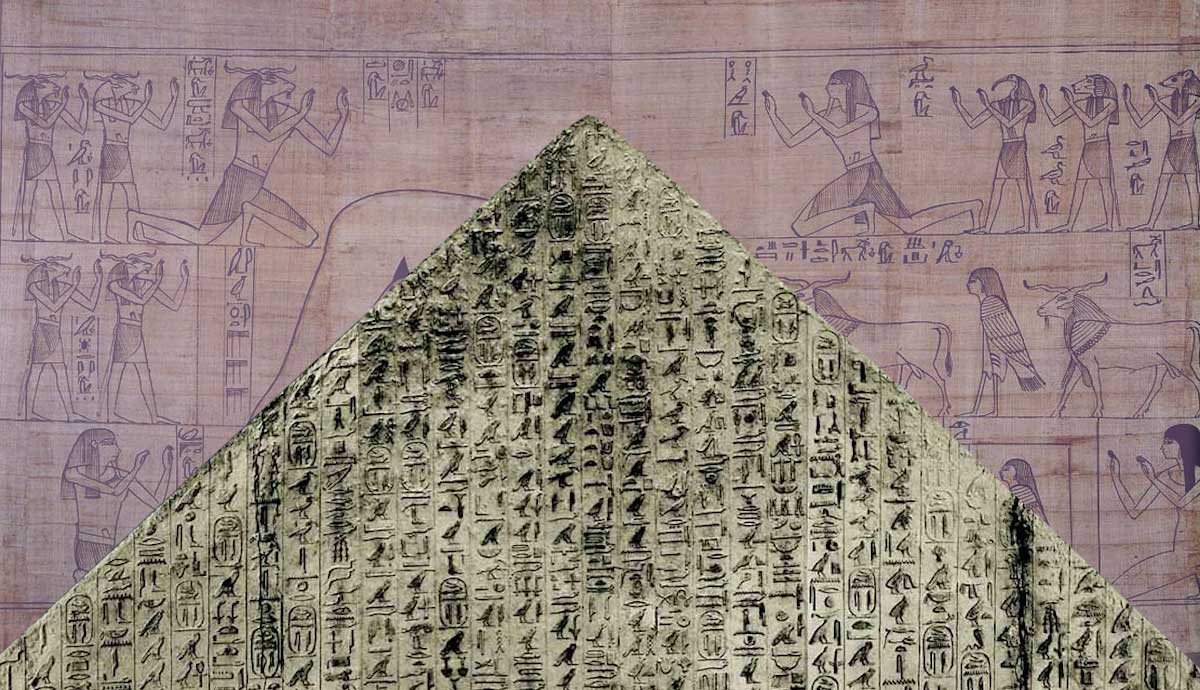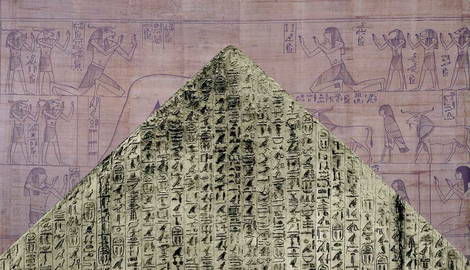
The earliest corpus of texts from ancient Egypt comes from inside the pyramids of the Old Kingdom pharaohs and queens. These “Pyramid Texts” were carved on the inner walls, ceilings, and furniture of pharaohs’ tombs, and once translated revealed some unexpected beliefs and stories about the early Egyptian kings. One of the most puzzling passages of the Pyramid Texts is the so-called ancient Egyptian “Cannibal Hymn”, in which the king in his afterlife is presented as a blood-thirsty devourer of gods. Let’s take a deep look into one of the most strange and unsettling pieces of early Egyptian literature.
The Pyramid Texts and the Ancient Egyptian Cannibal Hymn

It is always difficult to know when the “first” of something happened in history. We still do not know exactly when and where the Egyptian religion started, and the same goes for written texts. In the case of Egypt, there are countless treasures still covered in sand that have remained undiscovered for millennia. This is why, when referring to the so-called Pyramid Texts, although we cannot claim that they are the “first” religious texts in Egyptian history, it can be said with certainty that they are the earliest known Egyptian religious texts.
The Pyramid Texts were not written on papyrus like the ancient Egyptian books we are used to, but rather they were carved onto the inner walls of some pyramids during Old Kingdom times. To date, eleven pyramids are known to have any or all the Pyramid Texts inscribed. Six pharaohs, and five of their wives. Traditionally, Egyptologists have divided the Pyramid Texts into several “Utterances”, because it is believed that they had been made to be read by the priests who conducted the burial ceremonies. The texts themselves deal with several religious motifs regarding the afterlife of the pharaohs or queens. It was believed that only through a specific set of actions they would be transformed into an Akh (a part of the soul, according to the Egyptians) and fly safely into an eternal life of joy and gratitude.
Of these Utterances, the ones commonly named “the Cannibal Hymn” remains the most puzzling. These are found only in two pyramids: the ones belonging to Unas and Teti. The Unas Cannibal Hymn, however, is the longest and most complete. It is, too, one of the most widely misinterpreted pieces of Egyptian writing. We will analyze it in depth, but first, some biographical context is needed.
Who Was King Unas?

Unas (also spelled Unis or Wenis) was the last ruler of the 5th Dynasty of Egypt, in the midst of a time known to historians as the “Golden age of pyramids”. Most of the Egyptian pyramids we know well today were built during this particular Old Kingdom dynasty. Unas’ pyramid was built around 2300 BCE in Saqqara, near modern Cairo, and although it now lies in ruins it was once one of the more perfect smooth-sided limestone pyramids of its time.
The early kings of Egypt were expected to govern the country according to what French mythographer Georges Dumézil called the “tripartite ideology”. In his so-called trifunctional hypothesis, primitive Indo-European kings had to embody the whole of society, which was composed of three kings of men: priests, warriors, and farmers. This meant that the king was supposed to successfully wage war against the enemies of the country, feed the people, and exert sovereignty over both the worldly and supernatural realms. Accordingly, accounts from the time of Unas mention his military exploits in southern Canaan, how he maintained trade relations with Nubia and the Levant, and of course, they portray him as a son of Re and an equal to Osiris. This last aspect of Unas’ reign, the religious aspect, is exceptionally told in his Pyramid Texts, which we will review.
The Four Cardinal Points of Earth

The Pyramid Texts deal with the death and resurrection of the king, and his ascent to the sky with the help of Atum-Re, where he will become Osiris. This process has a series of stages, which are told in a very interesting narrative style. The first stage deals with the claiming of the “place of the four pillars”, that is, earth with its four cardinal points. The Texts describe how a number of gods, who bear witness to this claim, go and fetch the local gods in every corner of Egypt to follow suit. Seth and Nephthys appeal to Upper Egypt’s gods, Osiris and Isis do the same with the Lower Egypt’s gods, Thoth travels to the West, and Horus to the East.
And so, everywhere in the country, it is known that Unas is the almighty king of Egypt. Utterance 217 (all excerpts come from Myriam Lichtheim’s translation of the original Texts) reads:
“This Unas comes, a spirit indestructible; If he wishes you to die, you will die; If he wishes you to live, you will live!”
Unas in the Sky with Reed-Floats

After asserting his kingship, Unas starts to ascend into the sky where his father, Atum-Re, dwells:
“Re-Atum, your son comes to you; Unas comes to you; Raise him with you, hold him in your arms; He is your son, of your body, forever!”
He is lifted by Shu, the god of air, and then the sky-goddess, Nut, takes his hand to welcome him into the sky. She invites Unas to join her in prayer, and then the king needs to go through a cleansing ritual. The mythical place where the cleansing takes place is known as the Field of Rushes, and it is supposedly located in the Eastern sky.
The sky is imagined, in Egyptian mythology, as a counterpart to the river Nile. Thus, the safest way to traverse it is on top of some reed-floats, which are conducted by a ferryman. This is the part where the text becomes hard to interpret, as it mentions some divinities that do not appear in other, later texts. The references are also very vague and metaphorical:
“He [Unas] subjects to himself those who have gone there [to the sky]; They bring him those four elder spirits; The chiefs of the sidelock wearers; Who stand on the eastern side of the sky; Leaning on their staffs; That they may tell this Unas’s good name to Re; Announce this Unas to Nehebkau; And greet the entry of this Unas”.
The term “sidelock wearers” refers to the fact that children in Egypt had their heads shaven, except for a lock of hair to one side of their head. And Nehebkau was an early snake deity, but little is known about him. Thanks to these deities, who grant him access to the sky, he finally takes his seat in the afterlife. And then, all hell breaks loose.
The Cannibal Hymn

“Sky rains, stars darken; The vaults quiver, earth’s bones tremble; The planets stand still; At seeing Unas rise as power; A god who lives on his fathers; Who feeds on his mothers!”
(Utterance 273)
This fragment implies that Unas is stronger than the gods and goddesses that came before him. But Unas is not alone. He has many helpers, however, they are “under his feet”, that is, their power is not nearly as great as Unas’. The texts in Unas’ funerary chamber continue to mention that he can command other gods to do his will, and that at one point he grows soul-seeking, flame-spewing serpents on his forehead. In fact, there are a number of animal powers he masters:
“Unas is the bull of heaven; Who rages in his heart; Who lives on the being of every god; Who eats their entrails”.
Contrary to the rest of Egyptian literature, where the topic of the king’s or the gods’ death is avoided, Utterances 273 and 274 of the Pyramid Texts, aptly called the “Cannibal Hymn”, are quite explicit. He feeds on everything the gods have to offer, he “eats their magic, swallows their spirits”. The god Khons, upon Unas’ orders, slits the throats of several gods and serves their entrails to the king in a dinner-pot. Mention of severed body parts and the eating of organs are aplenty in the Cannibal Hymn. But without a doubt the most debated and mysterious verses of this “Hymn” are found to the end of Utterance 274:
“He has smashed bones and marrow; He has seized the hearts of gods; He has eaten the Red, swallowed the Green; Unas feeds on the lungs of the wise; Likes to live on hearts and their magic”.
The meaning behind this is, even today, not clear. But it may be helpful to discuss some of the available interpretations.
Did Cannibalism Exist in Egypt?

Although he has gained ill fame in recent years due to his involvement in the smuggling of Egyptian antiquities to the British Museum, Egyptologist Ernest Alfred Wallis Budge was, at the beginning of the 20th century, one of the most renowned experts on ancient Egyptian texts. His most famous finding was the so-called Papyrus of Ani, containing one of the most beautiful versions of the Book of the Dead. He also published around 150 books on different subjects.
His 1911 work, Osiris and Resurrection in Egypt, contains a bold claim: Egyptians invented the Osiris myth in order to force the population to abandon their old habit of cannibalism. The main source for this theory was the Cannibal Hymn, where cannibalism certainly seems to be described in detail. According to him, then, the state priests of the Old Kingdom started telling the tale of the death and dismemberment of Osiris as a means of making such practices taboo. No longer were dead bodies allowed to be eaten, instead, they had to be mummified as a whole and protected for their afterlife.
Other (Better) Interpretations of the Ancient Egyptian Cannibal Hymn

At first, scholars seemed to get behind Budge’s ideas, but soon enough, it became apparent that the evidence presented by him was insufficient to claim with certainty that Egyptians practiced cannibalism at an early stage of their history. Or at any stage, for that matter. More modern studies and interpretations of the Pyramid Texts agree that their contents are not linked to reality but are highly metaphorical. In this sense, it is seen as an assertion of the power of Unas as a ruler in the sky and an embodiment of Osiris. His nourishment and his might come from the spirits of his fellow gods, now that he has come to live among them in the sky.
Finally, as Myriam Lichtheim has proved, when it is said that Unas “has eaten the Red”, the text refers to the Red Crown of Lower Egypt; Whereas the “Green” is the Wadjet, the cobra goddess of Upper Egypt. Far from being proof of cannibalism in ancient Egypt, the Cannibal Hymn is a celebration of the unification of the Two Lands of Lower and Upper Egypt under an almighty God, who was able to rule even from his throne in the sky.










